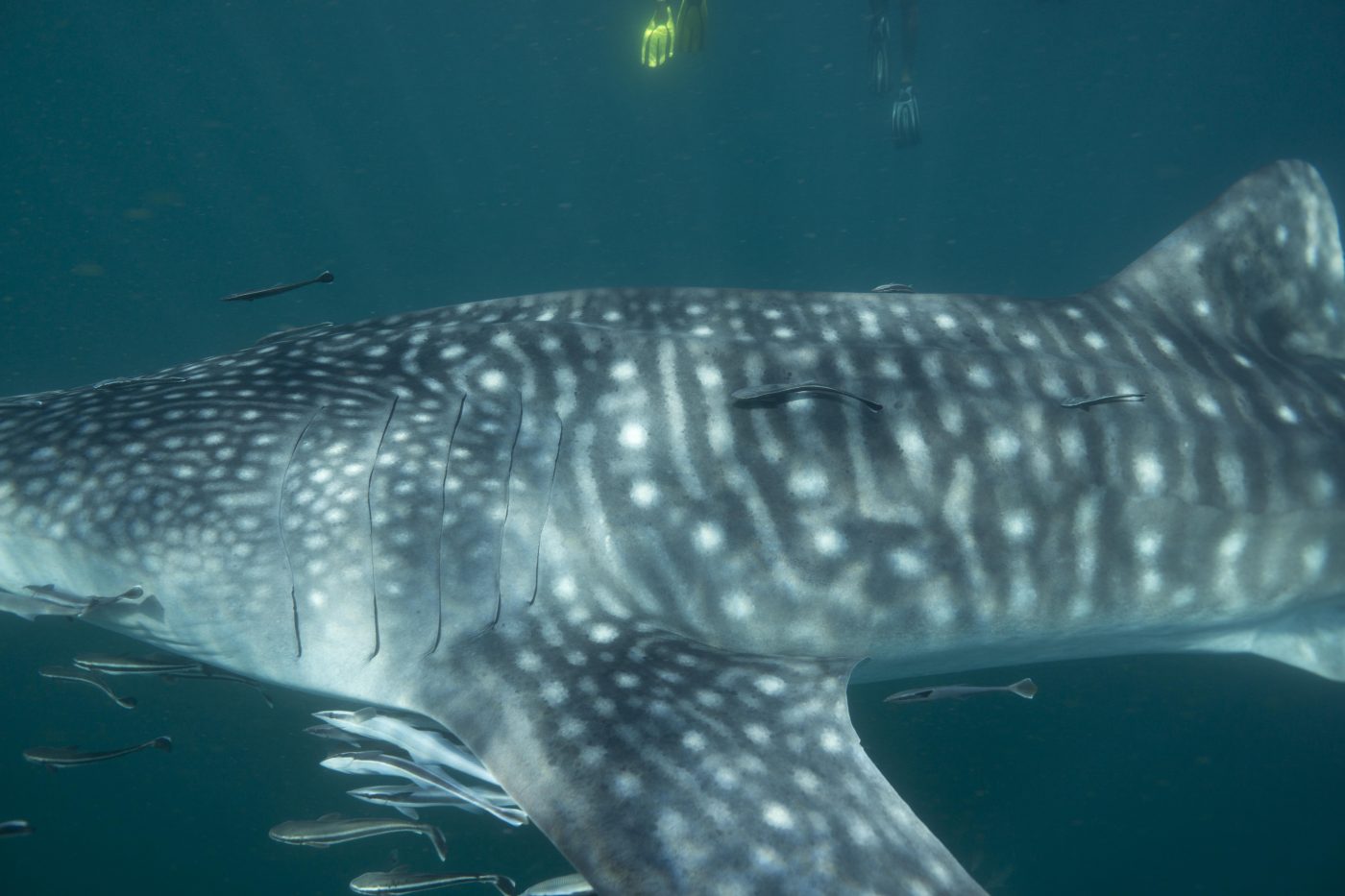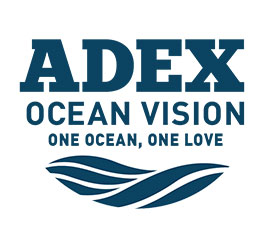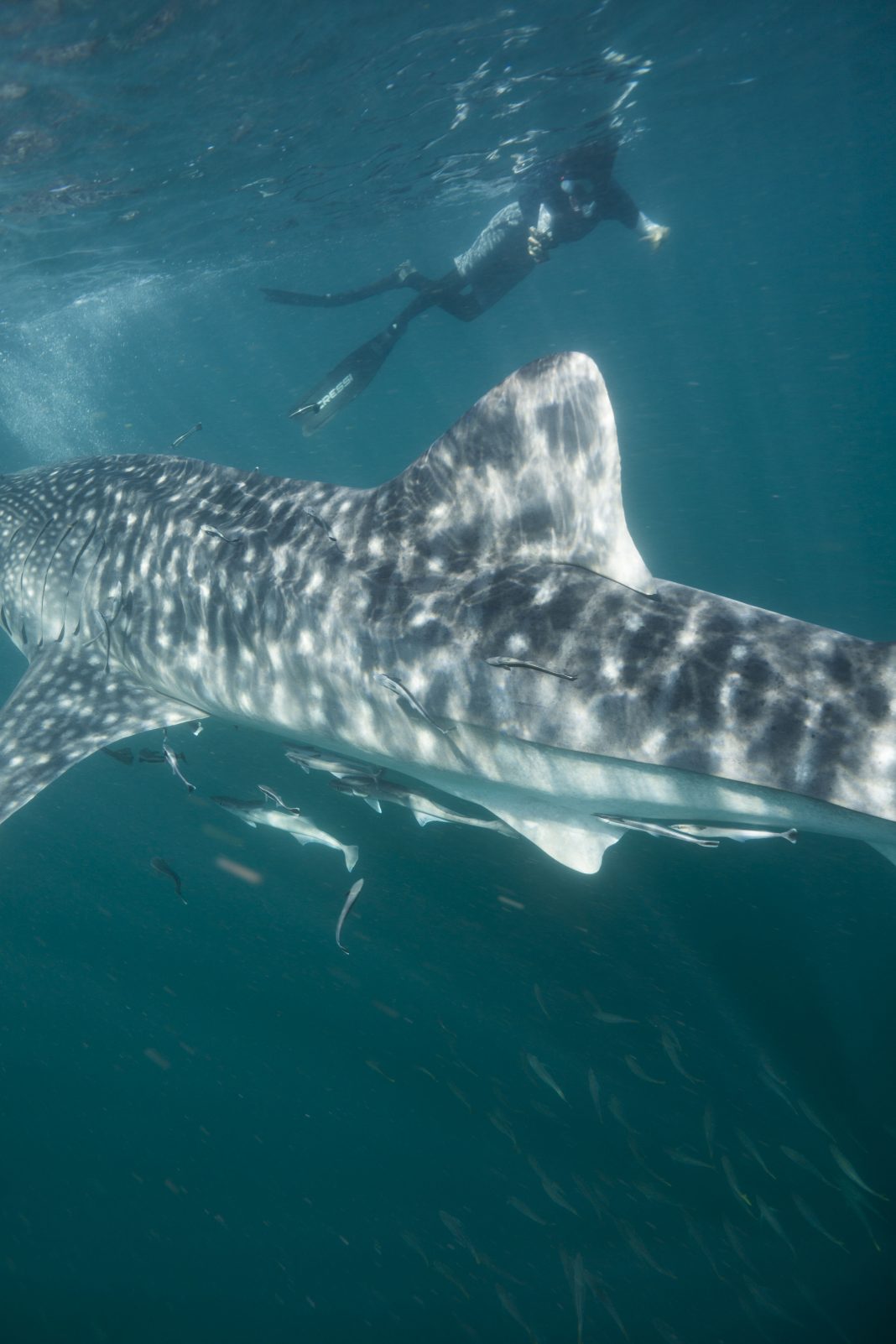To identify individual whale sharks, scientists analyse the spot pattern above the fin and behind the gills on the shark’s left flank. This spot pattern is unique for each individual
Text: Cat McCann || Images: David McCann
Marine biology students at Universiti Malaysia Sabah (UMS) have been taking advantage of the Movement Control Order to start building a database of whale shark sightings in Malaysia – including using divers’ posts on social media.
The travel restrictions brought on by the outbreak of coronavirus left the students unable to travel to survey sites, such as Pulau Gaya, where they recorded and identified their first official whale shark of the project, MY-065, on a survey just five days before the MCO was declared on 13 March 2020.
Making the best use of their time, the students are reviewing social media posts to tag footage of whale sharks and upload photos and videos to Wildbook (https://www.whaleshark.org) – the online library for global whale shark sightings.
The students have been using computer software to identify individuals through markings unique to each animal. For whale sharks, the spot pattern on their bodies is different for each shark, and these markings can be used to identify individuals. Think of it as a unique ‘fingerprint’ showing on their skin.

When the date, time, and location of sighting is uploaded, this simple action enables researchers to track movements of individual animals – a powerful tool for population and migratory studies.
“It has been an interesting start to the project” said Associate Professor Dr Mabel Manjaji Matsumoto, Interim Head, Endangered Marine Species Research Unit, Borneo Marine Research Institute, UMS. “The lockdown has obviously affected our capacity to carry out some projects, but has also provided us with unique opportunities to develop others, such as gathering citizen science data on social media like this. So far, four individual whale sharks have been identified during the MCO.”
“However, we need help to find more individuals. We are asking divers and snorkellers with footage of whale sharks to tag our project on their social media posts to make it easier for us to find – simply adding @Malaysia Whale Sharks will enable much easier identification. They can also upload the footage directly onto Wildbook.”
Diver’s holiday photos and videos have already yielded remarkable insights into the behaviour and biology of megafauna.
One such example is a whale shark sighted at Pulau Sipadan in October 2019. Footage provided by a diver enabled identification of this individual shark that had travelled from the Philippines – the first documented case of a whale shark moving between the Philippines and Malaysia.
Gonzalo Araujo, an Associate Research Fellow of the Endangered Marine Research Unit, UMS, and Director of Large Marine Vertebrates Research Institute Philippines (LAMAVE) – based in the Philippines, enthused:
“These results highlight that the importance of information from divers in monitoring programmes should not be underestimated – especially for species such as whale sharks. We suspected for a while that there was a link between whale shark populations in Philippines and Sabah. This has given us confirmation that this occurs, and the starting point for more research on the topic.”
“Old footage would be particularly valuable. It could give us a spatial reference for individual animals, as well as the potential history of their movements too.”
A local conservation organisation, S.E.A.S (Sea Education Awareness Sabah), has been assisting the project by going back through old footage and tagging the Malaysia Whale Shark project.
“Whale sharks are one of those species that divers are thrilled to catch on camera, being incredibly enigmatic megafauna, threatened with extinction and increasingly rare to see,” said David McCann, Conservation Manager for S.E.A.S, based at the dive operator Scuba Junkie’s Mabul Beach Resort.
“The recent MCO enabled us to go back through our old footage on social media and tag whale sharks. We had a huge backlog”, he laughed, “with thousands of dives at sites in the Semporna region, including Sipadan, Mabul, Kapalai and the islands of the Tun Sakaran Marine Park. We also went through footage taken in Kota Belud, near Kota Kinabalu.”
“It was quite a fun task, almost like a giant logbook of sightings – and it brought back many fond memories of how incredible Sabah is as a diving destination. We look forward to the end of travel restrictions, when we can take people back into the water and show them the unique marine biodiversity in Sabah…and hopefully take some new photos of whale sharks!”
Dr Mabel agreed, “Lockdowns may be easing worldwide, but travel restrictions will remain in place for a while yet. With time on their hands– and no doubt a backlog of photos and videos to sort through – divers have an opportunity to make a huge contribution.”
McCann concluded, “As divers, we enjoy the beauty of the underwater world – now more than ever we realise how much we miss it. It is only right that we seek to protect and aid it in any way possible assisting research and conservation through citizen science is a simple – yet effective – step to take.”
An update on this work will be provided at the Sabah Shark and Ray Forum, to be held in 2021.


